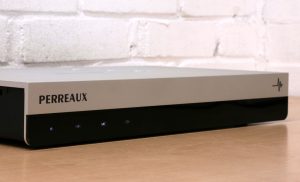How a phono stage really steps up your turntable set-up
 After a few weeks of serving our home theatre lovers, it’s time to indulge our friends, the Rapallo audiophiles.We thought we would have a chat about phono stages, after we called the Edwards Audio Apprentice MM phono stage Rapallo’s pick of the week.
After a few weeks of serving our home theatre lovers, it’s time to indulge our friends, the Rapallo audiophiles.We thought we would have a chat about phono stages, after we called the Edwards Audio Apprentice MM phono stage Rapallo’s pick of the week.
If you’re into vinyl, upgrading your phono stage can provide one of the most dramatic improvements to sound quality.
So what is a phono stage?
Back in the days of vinyl for everybody, the phono stage was built-in to receivers and amps, allowing direct connection of a turntable. But as CDs became the standard and started to replace vinyl, manufacturers of amplifiers removed the in-built phono stages and inputs.
So, what is it?
Basically, a phono stage is a type of pre-amplifier that provides the connection between the record player and an amplifier. It is specifically designed to serve a turntable. Here’s why…
First and foremost, when playing your turntable, the electrical output of the cartridge is way too small for the amplifier to work with it. Despite the fact that physically the sockets labelled ‘CD, Tuner, Aux, Line 1’ look exactly the same and will fit the plugs of a record player, the resultant electrical signal will simply be too small.
The second job of a phono stage is down to ‘RIAA equalisation’. When a vinyl record is cut, the grooves for bass are ‘cut’ and the ones for treble are ‘boosted’ so the grooves are trackable for the stylus. When you play your record, the RIVAA curve needs to be applied in reverse. This is the second job of the phono stage. A simple line-in socket intended for a radio tuner, DVD, CD player and the like, does not contain this RIAA correction circuitry.
No need to explain that this takes good engineering and expertise in circuit design, component choice and layout, something the amplifier manufacturers are not really interested in putting their resources in. This is exactly the reason why a good phono stage is an excellent idea to improve your turntable set-up.
Enter the phono stage with an input socket labelled ‘phono’.
What’s moving magnet and moving coil?
Before you go off and put a phono stage in your shopping trolley, you need to know what type of cartridge your turntable has. A different cartridge needs a different phono stage, see.
A cartridge has three main components: the needle, which sits in the grooves on your record, a magnet and a coil. As the coil or magnet move in relation to each other, they generate a voltage.
In the simplest terms, Moving-Magnet (MM) cartridges, are exactly what it sounds like. The part attached to the needle, is a magnet, which moves inside a surrounding coil of wire.
Moving Coil (MC) is the same basic components but the opposite way around. The coil rides on top of the needle surrounded by a magnet. Due to the smaller parts and greater precision, moving coil cartridges tend to be expensive compared to a moving magnet cartridge.
There is a lot of opinion out there about which one is better than the other. We won’t go into that discussion at this stage. The important thing here is that Moving Coil cartridges have a much lower output voltage compared to Moving Magnet cartridges, so they require a higher level of amplification before input to your amp.
When you look at phono stages names, you will often find ‘MM’ or ‘MC’ in their names. This is a referral to the type of cartridge they are capable of moving and it is important to make sure you match correctly. Most phono stages only handle Moving Magnet cartridges, although several of the phono stages we have on offer can of do both.
Which phono stage do you recommend?
As you will know by now, at Rapallo we try to offer options at different budgets, but always with excellent bang for buck in mind.
Edwards Audio, Cambridge Audio, Emotiva and Perreaux all are brands that have an outstanding reputation when it comes to Phono stages. Depending on your budget and set-up, we can highly recommend any of these brands.
Source: Cambridge Audio, Audio Appraisal, Emotiva